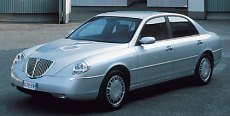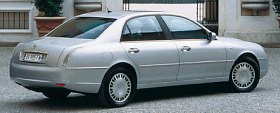|
 With
limited number of Greek alphabetic letters, Lancia does not have many
chances
to fail again. For 15 years, Lancia’s flagship models did not receive
sufficient
funding, therefore the Thema was just a little more than a repackaged
Fiat
Croma (although so was Saab 9000), the Kappa was a derivative of the
aging
Alfa 164. That saved cost, and allowed the cars to be priced lower than
equivalent BMW and Mercedes, but also hurt their competitiveness. The
formula
might work in the 80s, but no longer worked for the Kappa. Say, if a V6
Kappa was 15% cheaper than an equivalent BMW 5-series, which one would
you choose ? With
limited number of Greek alphabetic letters, Lancia does not have many
chances
to fail again. For 15 years, Lancia’s flagship models did not receive
sufficient
funding, therefore the Thema was just a little more than a repackaged
Fiat
Croma (although so was Saab 9000), the Kappa was a derivative of the
aging
Alfa 164. That saved cost, and allowed the cars to be priced lower than
equivalent BMW and Mercedes, but also hurt their competitiveness. The
formula
might work in the 80s, but no longer worked for the Kappa. Say, if a V6
Kappa was 15% cheaper than an equivalent BMW 5-series, which one would
you choose ?
That
said, brand image is increasingly important for large cars. No one
wants
the likes of Granada or Safrane anymore. They want something looking
expensive
and have a premium brand sticking on the bonnet. Fiat also wants to
make
Lancia its premium brand. After the failure of Kappa, it finally
understood
that building a premium brand requires decent development budget and
looser
control to production cost. They can no longer build another
second-class
luxury car. They must start from a flagship model, making it as
expensive
to feel as German rivals to change people’s perception to the brand.
However,
without a realistic price to attract people into Lancia showrooms, no
one
will know the improvement made on the new car. Therefore they must find
way to keep price lower than rivals without losing money. Again, the
secret
of achieving this is to share engines and transmissions with Fiat and
Alfa
Romeo, while leaving the chassis - which is decisive to the driving
character
of a car - unique.
So,
the next Greek alphabetic letter to Kappa, in Lancia’s dictionary, is
Thesis.
From concept to production, Thesis took a long time to take shape. Its
concept car, Dialogo, was reported by AutoZine in sometime around 1997
as I remember. Like the final production car, it was penned by American
designer Michael Robinson, now moved to head Fiat Design Center. The
design
emphasis one thing: classics. Everyone should notice its big grille
mounted
in front of sculpted bonnet, and the front wings clearly separate from
the engine compartment. Does it look like a pre-war classic car?
Chrysler
PT Cruiser might applied such retro design earlier, but Thesis has it
done
cleanly without compromise. You can see its bonnet and front wings
curve
smoothly towards the bumper. The whole thing is so clean, so creamy
smooth,
so elegant. Elegance is also enhanced by the diamond-shape headlights,
the laser-cut-looking assembly gap between bonnet and bumper, and the
chromed
lines separating the front wings and bumper. Turn 90°, side profile
is much more conventional. Turn to its tail, you will notice it looks
quite
similar to Rover 75, with the trunk lid slip towards the tail.
Nevertheless,
the Lancia has a unique LED taillights shaped as a vertical stripe. It
looks cool and elegant. It looks expensive. The first test has
passed.
 The
Thesis is built on a unique platform which won’t be used on other cars
in Fiat group. This is strange, considering Fiat was the inventor of
platform
sharing. Today, the Italian company is also the first car maker
quitting
platform sharing and enters the age of modular space-frame chassis.
Pioneered
by Fiat Multipla (the strange MPV), the company’s space-frame
technology
allows the chassis to be tailored to different cars, with flexible
dimensions
and flexible mountings for components to enable virtually unlimited
deviations. The
Thesis is built on a unique platform which won’t be used on other cars
in Fiat group. This is strange, considering Fiat was the inventor of
platform
sharing. Today, the Italian company is also the first car maker
quitting
platform sharing and enters the age of modular space-frame chassis.
Pioneered
by Fiat Multipla (the strange MPV), the company’s space-frame
technology
allows the chassis to be tailored to different cars, with flexible
dimensions
and flexible mountings for components to enable virtually unlimited
deviations.
The
steel space-frame chassis of Thesis measures 4.9 meters in length, very
long indeed. For instance, a Mercedes E-class is 100mm shorter.
Wheelbase
is less impressive. At 2803mm it equals to Volvo S80 but shorter than
the
E-class and 5-series. However, as Thesis is front-wheel-drive, just
like
the Volvo, it spends the wheelbase more efficiently to cabin room than
the rear-drive Mercedes and BMW. In terms of space, the Thesis is of
course
more spacious than Alfa 166 and Peugeot 607, but it does not break any
new ground either, because most other rivals are already very spacious.
While space race is no longer a thing customers ask for, quality
packaging
should be the first priority. In the Thesis cabin, you will see really
expensive materials covering everywhere, such as leather, Alcantara,
wool
and some understated real wood inserts. The cast-magnesium center
console
is another quality job. This is where it can beat any Volkswagen group
cabins - the solid feel of cup-holder sliding out of the magnesium
frame.
The big and soft seats are also unrivalled for their comfort. Well,
maybe
just inferior to Renault Vel Satis.
I rarely
talk about equipment, but because this is a strong card of Thesis we
must
go through once. First of all, the front seats have heating,
ventilation
and massager incorporated while rear passengers enjoy their own climate
control. Then, Lancia said there are a total of 54 CPUs in the car,
giving
variety functions such as memory customized settings, keyless entry and
start, electric door-opening-and-closing, radar cruise control and ESP.
And then there is a clever information and control system called
CONNECT.
This has been launched in Alfa 147 and Fiat Stilo, but the group’s most
luxurious flagship gets even more functions. Through the LCD screen on
center console, you can activate phone, TV, audio (via the 11 speakers
Bose Hi-Fi, by the way), navigation and a telematic information service
which help you to find routes, hotels, restaurant etc. via conversation
with real human. In case you don’t like to pay attention to the screen
during driving, you can use voice control instead.
Huge
size and lots of equipment leads to a heavy kerb weight - from 1680kg
of
the base 2.4-litre to 1750kg of range-topping V6. It is more than 100kg
heavier than equivalent BMW and Mercedes. I would have liked to see
more
powerful engines, but because Lancia cannot afford to develop its own
it
has to rely on the group’s existing engines. These consist of a couple
of Super Fire inline-5, a 2.4-litre JTD turbo diesel, a 3.0 V6 from
Alfa
Romeo and an Isuzu 3.0 V6 turbo diesel. The fastest is the 215hp Alfa
V6,
but even that can just accelerate from 0-60mph in 8.7 seconds.
Considering
the comfort bias of Thesis, engine is perhaps the most appropriate area
to compromise with cost concern.
The
base Super Fire engine is a 2.4-litre, with VVT, 2-stage variable
intake
and balance shaft to generate 170hp and 167lbft. Despite of 6-speed
manual
gearbox, it is still painfully slow.
Next
up is another Super Fire engine. Basically a detuned version of the
late
Fiat Coupe. Displacing 2.0-litre, mildly charged by a light-pressure
turbocharger
to deliver 185hp and 227 lbft. It also has balance shafts and VVT. The
turbo even gets variable nozzle. The extra torque gives it much
improved
overtaking ability than the 2.4.
The
JTD is still 2-valve per cylinder. But there is nothing wrong with
common-rail
injection, VTG turbo and intercooler. It produces 150hp and 225lbft in
a less refined way than BMW 520d.
You
might remember the Isuzu V6 - it is sold to Saab 9-5 and Renault Vel
Satis
as well.
The
3.0 V6 is best of the range. At 194 lbft, it is not very torquey.
However,
in terms of smoothness and eagerness it is lovely. Beautiful vocal in
Alfa
tradition. Were it quieter, it would have suited the luxurious manner
of
Thesis. It mates with a 5-speed automatic with Tiptronic-style manual
override.
Shift quality is smooth and responsive enough.
Thesis
rides on unique suspensions. The front are 5-link suspensions, which is
said to allow virtual steering axle to be as close as possible to the
wheel
center, thus benefit steering accuracy and response. Rear suspensions
are
a new design called "multiple-arm" suspensions. Each consists of
aluminium
upper and lower arms, a cast iron pillar and a steel beam. It is said
to
allow greater degree of freedom thus benefit bump absorption. There is
also an adaptive damping called "Skyhook", similar to the one using by
Maserati Spyder.
On
motorway, the Thesis’ 5mm-thick glazing and sound insulation work
perfectly
to keep wind and tyre noise out of the cabin. It is so quiet that the
vocal
of Alfa V6 become obvious. The chassis feels solid, free of rattles and
shake. The ride is exceptional supple. Skyhook deals remarkably with
rough
surfaces and even pot holes. The suspension setting bias towards the
soft
side, more like a traditional Jaguar instead of an Italian car. German
saloons ride far firmer.
The
trade off is handling agility. At 8/10 effort, the Thesis handles
satisfactorily.
It changes direction without reluctance, it resists roll well and
provides
bags of grip. However, what separate a good driver’s car from an
average
one is the last couple of tenths, and here you can see the Thesis
suffers.
Push harder, and you won’t have confidence in its light yet isolated
steering.
The car turns into understeer quicker than German saloons, with ESP
intervene
gently to correct understeer while reducing throttle.
Anyway,
if we judge Thesis by the standard of driver’s car, we will be wrong.
Thesis
is tuned to be a comfortable luxurious car - to please Lancia’s
customers
or to distinguish it from German cars. Lancia’s intention is very
clear,
from the styling, from the cabin, from the refinement and from the ride
quality you can see this is a pure comfortable car. Having understood
that
we will applause for its fine handling in most conditions. Compare with
Japanese and Korean executive sedans, Thesis is still recognizably a
European
car. |